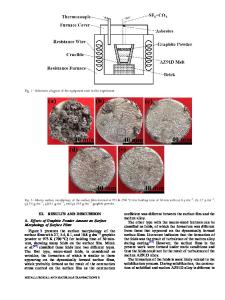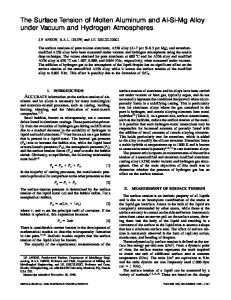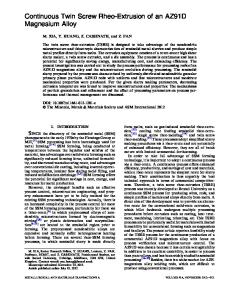Characterization of the Surface Film Formed on Molten AZ91D Magnesium Alloy in Atmospheres Containing SO 2
- PDF / 969,104 Bytes
- 8 Pages / 593.972 x 792 pts Page_size
- 111 Downloads / 310 Views
MAGNESIUM and its alloys are being widely used in many areas because of their good properties, such as high specific strength and low density.[1] However, molten Mg alloys oxidize rapidly during the casting and handling process.[2] Cover gases containing SF6 mixed with N2 or dry air are commonly used to protect molten Mg alloys. Recently, the use of SF6 has become increasingly restricted because of its high cost as well as environmental issues.[3] The Kyoto Protocol calls for a reduction in SF6 use. Therefore, new substitutes for SF6 in the Mg industry must be found. To find suitable industrial alternatives to SF6, the mechanism by which these gases protect the melt should first be understood. Only then will new gases with similar protecting properties be discovered. Couling et al.[4] first studied the protective effect of Mg alloys under atmospheres containing SF6. They found that SF6 was consumed in the protection process and attributed this result to the absorption of SF6 on a MgO surface or to a reaction that forms MgF2. Recently, Cashion[5] studied the characterization of the surface films formed in cover gas mixtures containing SF6 using several analytical techniques. He found that the films consisted of MgO and MgF2 and that the film thickness increased with increased protective time. These results were partly confirmed by Pettersen et al.[6] Aarstad’s studies[7] indicated that particles containing MgF2 formed on the interface between the MgO film and bulk Mg; these particles grew until they covered 25 to 50 pct of the total surface area. XIAN-FEI WANG, Doctoral Candidate, and SHOU-MEI XIONG, Professor, are with the Department of Mechanical Engineering, Tsinghua University, Beijing 100084, P.R. China. Contact e-mail: [email protected] Manuscript submitted October 18, 2011. Article published online July 7, 2012 4406—VOLUME 43A, NOVEMBER 2012
Sulfur dioxide (SO2) mixed with carrier gases can also be used to protect molten Mg alloys.[8] However, the protection mechanism of SO2-containing cover gases on the molten Mg alloy has not been clearly understood. In this article, the microstructure and composition of the surface film formed in a controlled atmosphere containing SO2 gas were investigated.
II.
EXPERIMENTAL METHODS
AZ91D magnesium alloy was used in the current experiments. The chemical composition of the alloy in weight percent was 8.7Al, 0.56Zn, 0.2034Mn, 0.0005Cu, 0.001Fe, 0.0007Ni, 0.031S, and Mg balance. An automatic furnace with a volume of 60 L was used in this experiment, as shown in Figure 1. AZ91D alloy was first added to a stainless steel bowl in the crucible of an open melting furnace that produces a mixed gas of N2 containing SO2; the gas was controlled by mass flow meters. Twenty minutes later, heat was applied until a constant temperature was reached, and then a scraper was used to remove the old surface film so that a fresh melt surface could be obtained. The melt was then left in the furnace at different lengths of time. The stainless steel bowl containing the melt was then lifted to the cooling
Data Loading...











